
Alamo (ALG)
We aren’t fans of Alamo. Its underwhelming revenue growth and failure to generate meaningful free cash flow is a concerning trend.― StockStory Analyst Team
1. News
2. Summary
Why We Think Alamo Will Underperform
Expanding its markets through acquisitions since its founding, Alamo (NSYE:ALG) designs, manufactures, and services vegetation management and infrastructure maintenance equipment for governmental, industrial, and agricultural use.
- Gross margin of 25.5% reflects its high production costs
- Projected sales growth of 5.4% for the next 12 months suggests sluggish demand
- A silver lining is that its performance over the past five years shows its incremental sales were more profitable, as its annual earnings per share growth of 13.2% outpaced its revenue gains


Alamo doesn’t fulfill our quality requirements. We see more lucrative opportunities elsewhere.
Why There Are Better Opportunities Than Alamo
High Quality
Investable
Underperform
Why There Are Better Opportunities Than Alamo
Alamo is trading at $165.41 per share, or 14.4x forward P/E. This multiple is lower than most industrials companies, but for good reason.
It’s better to pay up for high-quality businesses with higher long-term earnings potential rather than to buy lower-quality stocks because they appear cheap. These challenged businesses often don’t re-rate, a phenomenon known as a “value trap”.
3. Alamo (ALG) Research Report: Q3 CY2025 Update
Specialized equipment manufacturer for infrastructure and vegetation management Alamo Group (NYSE:ALG) reported Q3 CY2025 results exceeding the market’s revenue expectations, with sales up 4.7% year on year to $420 million. Its non-GAAP profit of $2.34 per share was 11.3% below analysts’ consensus estimates.
Alamo (ALG) Q3 CY2025 Highlights:
- Revenue: $420 million vs analyst estimates of $407.6 million (4.7% year-on-year growth, 3.1% beat)
- Adjusted EPS: $2.34 vs analyst expectations of $2.64 (11.3% miss)
- Adjusted EBITDA: $55.01 million vs analyst estimates of $58.77 million (13.1% margin, 6.4% miss)
- Operating Margin: 8.9%, down from 10% in the same quarter last year
- Market Capitalization: $2.15 billion
Company Overview
Expanding its markets through acquisitions since its founding, Alamo (NSYE:ALG) designs, manufactures, and services vegetation management and infrastructure maintenance equipment for governmental, industrial, and agricultural use.
Founded in 1969, the company has operations across North America, Europe, and Australia. Alamo Group's product portfolio includes equipment such as mowers, excavators, vacuum trucks, street sweepers, snow removal equipment, and forestry and tree care machinery.
Alamo operates through two primary segments: the Vegetation Management Division and the Industrial Equipment Division. The Vegetation Management Division includes products for agricultural, governmental, and commercial markets, while the Industrial Equipment Division concentrates on specialized trucks and heavy equipment for infrastructure maintenance and construction applications.
The company sells its products through a network of independent dealers, distributors, and directly to end-users in some cases. A significant portion of Alamo's sales comes from governmental agencies and related contractors, particularly for infrastructure maintenance equipment.
Alamo has historically grown via M&A, and one notable acquisition in recent years includes Royal Truck & Equipment, a manufacturer of truck-mounted highway attenuator trucks and other specialty vehicles for traffic control and highway safety. This acquisition expanded its presence in the highway safety equipment market. The company also acquired Morbark, which significantly strengthened its position in the forestry and tree care equipment markets.
4. Agricultural Machinery
Agricultural machinery companies are investing to develop and produce more precise machinery, automated systems, and connected equipment that collects analyzable data to help farmers and other customers improve yields and increase efficiency. On the other hand, agriculture is seasonal and natural disasters or bad weather can impact the entire industry. Additionally, macroeconomic factors such as commodity prices or changes in interest rates–which dictate the willingness of these companies or their customers to invest–can impact demand for agricultural machinery.
Alamo’s peers and competitors include Lindsay (NYSE:LNN) and AGCO (NYSE:AGCO)
5. Revenue Growth
Reviewing a company’s long-term sales performance reveals insights into its quality. Any business can experience short-term success, but top-performing ones enjoy sustained growth for years. Over the last five years, Alamo grew its sales at a mediocre 6.6% compounded annual growth rate. This was below our standard for the industrials sector and is a poor baseline for our analysis.
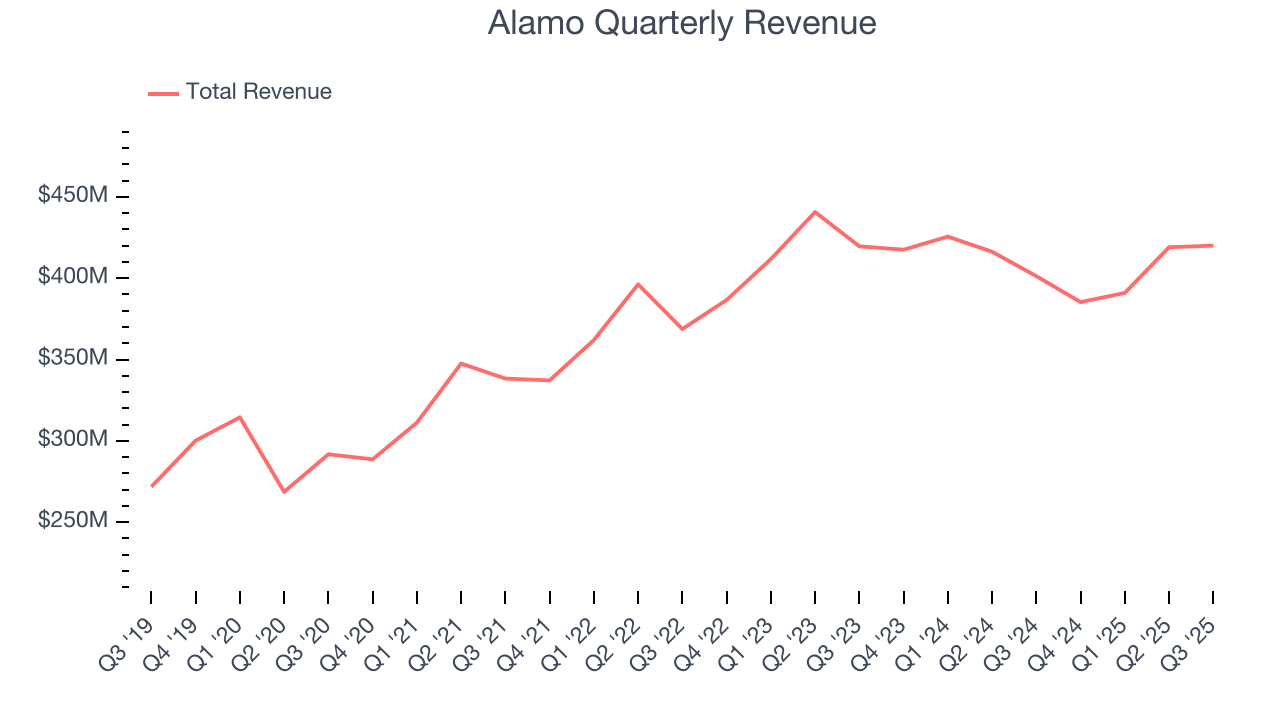
Long-term growth is the most important, but within industrials, a half-decade historical view may miss new industry trends or demand cycles. Alamo’s performance shows it grew in the past but relinquished its gains over the last two years, as its revenue fell by 1.3% annually. Alamo isn’t alone in its struggles as the Agricultural Machinery industry experienced a cyclical downturn, with many similar businesses observing lower sales at this time. 
This quarter, Alamo reported modest year-on-year revenue growth of 4.7% but beat Wall Street’s estimates by 3.1%.
Looking ahead, sell-side analysts expect revenue to grow 5.3% over the next 12 months. While this projection indicates its newer products and services will spur better top-line performance, it is still below average for the sector.
6. Gross Margin & Pricing Power
Gross profit margin is a critical metric to track because it sheds light on its pricing power, complexity of products, and ability to procure raw materials, equipment, and labor.
Alamo has bad unit economics for an industrials company, giving it less room to reinvest and develop new offerings. As you can see below, it averaged a 25.5% gross margin over the last five years. Said differently, Alamo had to pay a chunky $74.50 to its suppliers for every $100 in revenue. 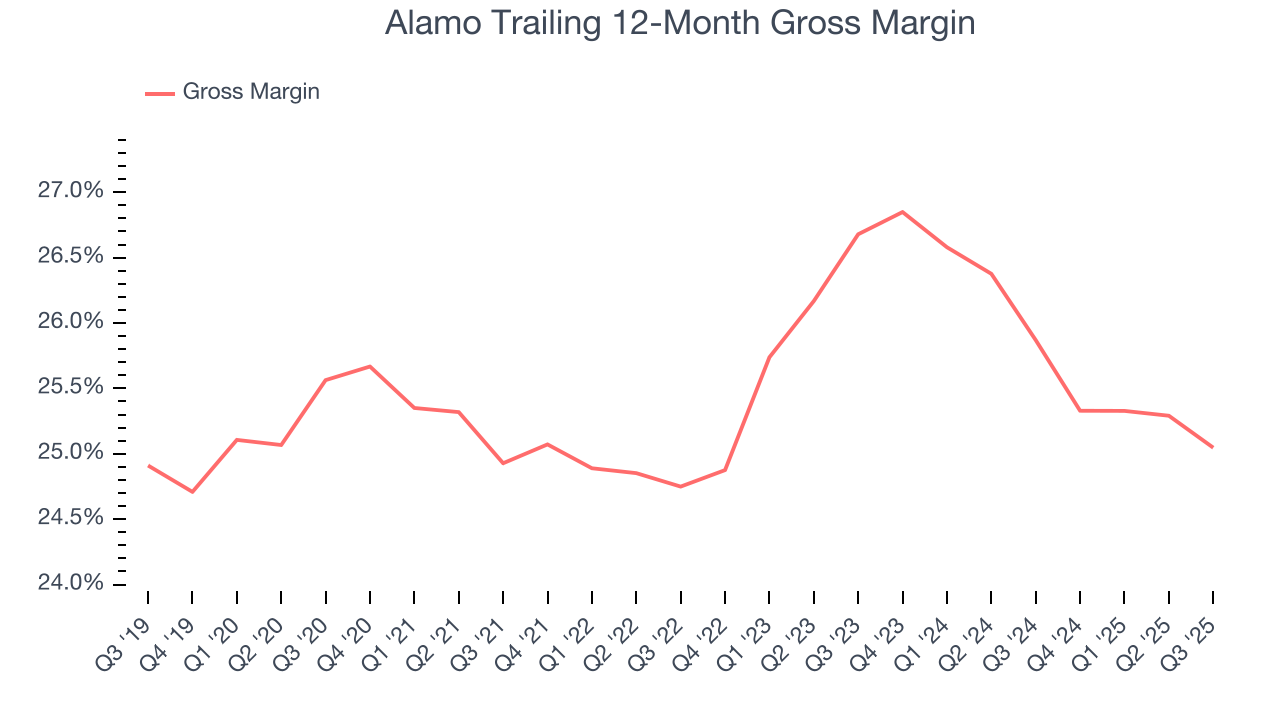
Alamo produced a 24.2% gross profit margin in Q3, in line with the same quarter last year. On a wider time horizon, the company’s full-year margin has remained steady over the past four quarters, suggesting its input costs (such as raw materials and manufacturing expenses) have been stable and it isn’t under pressure to lower prices.
7. Operating Margin
Operating margin is one of the best measures of profitability because it tells us how much money a company takes home after procuring and manufacturing its products, marketing and selling those products, and most importantly, keeping them relevant through research and development.
Alamo has managed its cost base well over the last five years. It demonstrated solid profitability for an industrials business, producing an average operating margin of 10.1%. This result was particularly impressive because of its low gross margin, which is mostly a factor of what it sells and takes huge shifts to move meaningfully. Companies have more control over their operating margins, and it’s a show of well-managed operations if they’re high when gross margins are low.
Looking at the trend in its profitability, Alamo’s operating margin rose by 1.7 percentage points over the last five years, as its sales growth gave it operating leverage.
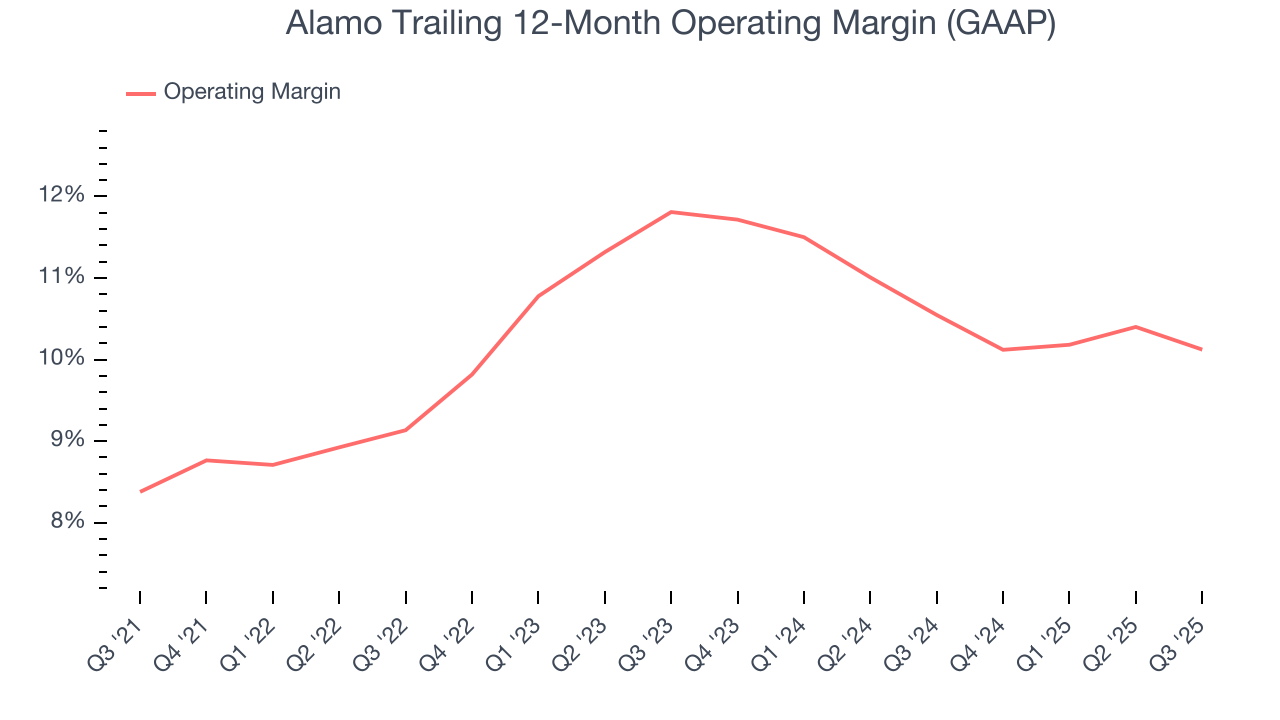
This quarter, Alamo generated an operating margin profit margin of 8.9%, down 1 percentage points year on year. Since Alamo’s operating margin decreased more than its gross margin, we can assume it was less efficient because expenses such as marketing, R&D, and administrative overhead increased.
8. Earnings Per Share
We track the long-term change in earnings per share (EPS) for the same reason as long-term revenue growth. Compared to revenue, however, EPS highlights whether a company’s growth is profitable.
Alamo’s EPS grew at a remarkable 13.2% compounded annual growth rate over the last five years, higher than its 6.6% annualized revenue growth. This tells us the company became more profitable on a per-share basis as it expanded.
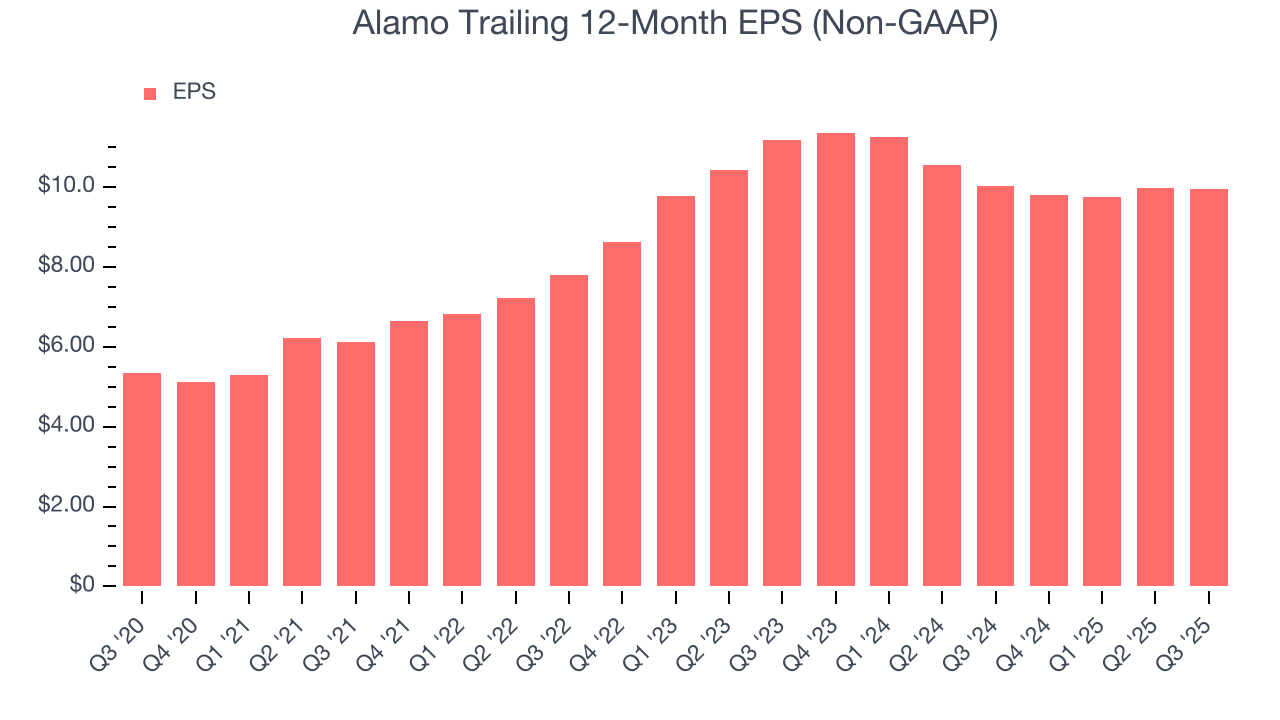
We can take a deeper look into Alamo’s earnings to better understand the drivers of its performance. As we mentioned earlier, Alamo’s operating margin declined this quarter but expanded by 1.7 percentage points over the last five years. This was the most relevant factor (aside from the revenue impact) behind its higher earnings; interest expenses and taxes can also affect EPS but don’t tell us as much about a company’s fundamentals.
Like with revenue, we analyze EPS over a shorter period to see if we are missing a change in the business.
For Alamo, its two-year annual EPS declines of 5.7% mark a reversal from its (seemingly) healthy five-year trend. We hope Alamo can return to earnings growth in the future.
In Q3, Alamo reported adjusted EPS of $2.34, down from $2.38 in the same quarter last year. This print missed analysts’ estimates, but we care more about long-term adjusted EPS growth than short-term movements. Over the next 12 months, Wall Street expects Alamo’s full-year EPS of $9.94 to grow 20.5%.
9. Cash Is King
Although earnings are undoubtedly valuable for assessing company performance, we believe cash is king because you can’t use accounting profits to pay the bills.
Alamo has shown mediocre cash profitability over the last five years, giving the company limited opportunities to return capital to shareholders. Its free cash flow margin averaged 4.9%, subpar for an industrials business.
Taking a step back, an encouraging sign is that Alamo’s margin expanded by 3.3 percentage points during that time. The company’s improvement shows it’s heading in the right direction, and we can see it became a less capital-intensive business because its free cash flow profitability rose more than its operating profitability.
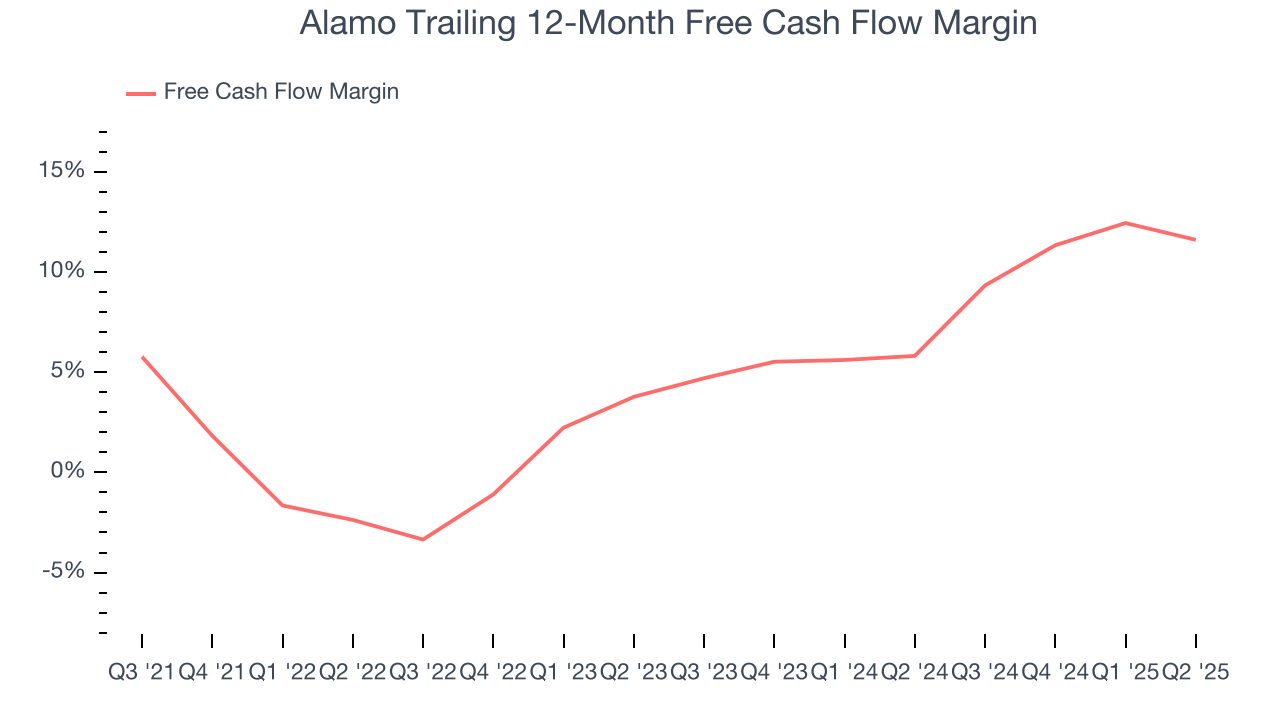
10. Return on Invested Capital (ROIC)
EPS and free cash flow tell us whether a company was profitable while growing its revenue. But was it capital-efficient? A company’s ROIC explains this by showing how much operating profit it makes compared to the money it has raised (debt and equity).
Alamo’s management team makes decent investment decisions and generates value for shareholders. Its five-year average ROIC was 11.6%, slightly better than typical industrials business.
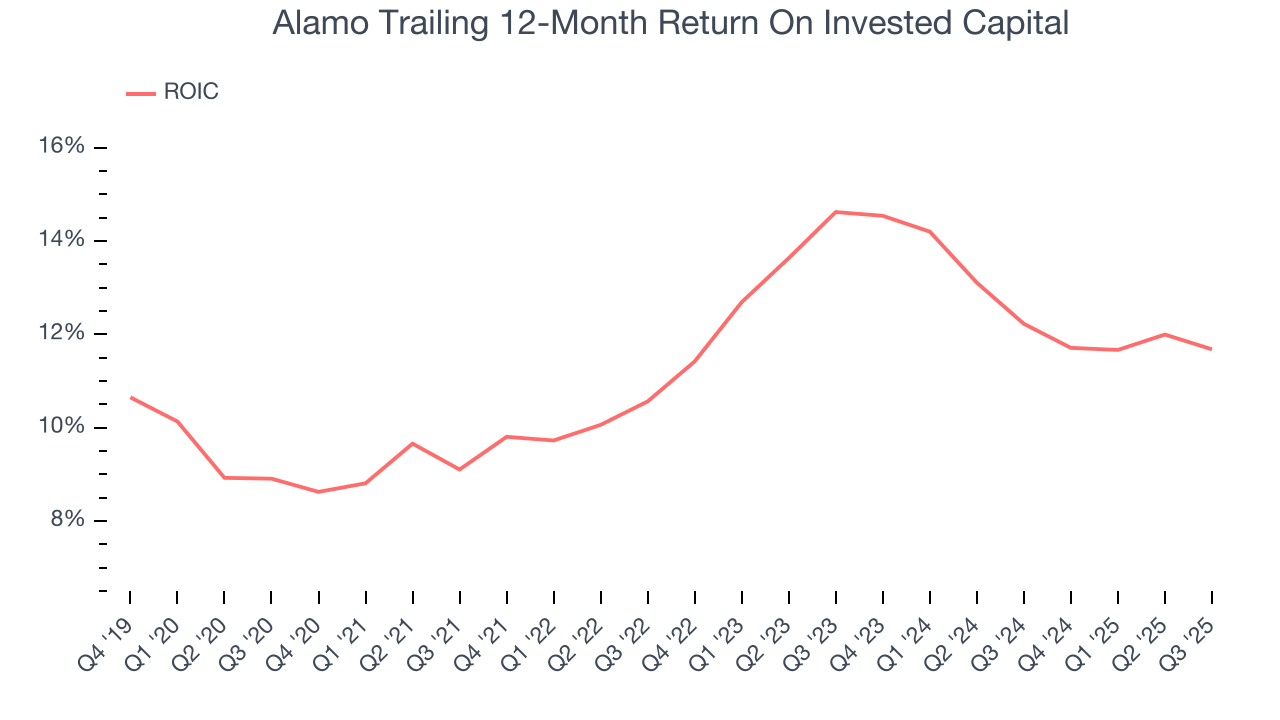
We like to invest in businesses with high returns, but the trend in a company’s ROIC is what often surprises the market and moves the stock price. Over the last few years, Alamo’s ROIC averaged 2.1 percentage point increases each year. This is a good sign, and we hope the company can keep improving.
11. Key Takeaways from Alamo’s Q3 Results
We enjoyed seeing Alamo beat analysts’ revenue expectations this quarter. On the other hand, its EBITDA missed and its EPS fell short of Wall Street’s estimates. Overall, this was a weaker quarter. The stock traded down 2.7% to $168.28 immediately after reporting.
12. Is Now The Time To Buy Alamo?
Updated: December 4, 2025 at 9:05 PM EST
When considering an investment in Alamo, investors should account for its valuation and business qualities as well as what’s happened in the latest quarter.
Alamo’s business quality ultimately falls short of our standards. To kick things off, its revenue growth was mediocre over the last five years, and analysts expect its demand to deteriorate over the next 12 months. And while its rising cash profitability gives it more optionality, the downside is its gross margins are lower than its industrials peers. On top of that, its low free cash flow margins give it little breathing room.
Alamo’s P/E ratio based on the next 12 months is 14.7x. This valuation multiple is fair, but we don’t have much faith in the company. We're pretty confident there are superior stocks to buy right now.
Wall Street analysts have a consensus one-year price target of $219.75 on the company (compared to the current share price of $166.80).
Although the price target is bullish, readers should exercise caution because analysts tend to be overly optimistic. The firms they work for, often big banks, have relationships with companies that extend into fundraising, M&A advisory, and other rewarding business lines. As a result, they typically hesitate to say bad things for fear they will lose out. We at StockStory do not suffer from such conflicts of interest, so we’ll always tell it like it is.













